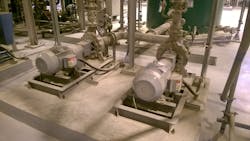Many papers and articles have been published about cavitation, net positive suction head (NPSH) requirements and pressure drop on suction piping of pumps. However, complicated cases of how all flow, NPSH, thermal movements and stress analysis requirements are considered simultaneously and how an optimum configuration is achieved for suction piping of pumps have not been thoroughly discussed.
Flow management, cavitation avoidance and proper stream of liquid at suction of pumps are key topics for reliability, safety and operation of pumps. For pumps, the suction piping is almost always more critical than the discharge piping, even though the discharge piping operates at much higher pressure than the suction.
In addition to key flow and NPSH requirements, the suction piping configuration should not cause excessive misalignment between the pump and its driver. As a rough indication, the shaft displacement of the pump shaft should be less than 300 micrometers (0.3 mm). This is closely related to allowable nozzle loads, and piping reaction loads should be as low as possible. Satisfying different nozzle load conditions ensure that any pump casing distortion will be within allowable limits. An important reaction load is from the suction piping, because the diameter of suction piping is more than the diameter of discharge piping — due to flow requirements. Also, the suction piping is relatively shorter and stiffer than the discharge piping. A discharge piping of a pump can be provided with many different loops and flexibility provisions; therefore, the load on discharge nozzle is more manageable and generally lower.
Challenges at suction
Suction piping systems of pumps have always been challenging. This is due to the sensitivity of the pump to the flow problems and pressure drop on the suction and due to the larger size of the piping normally used in the suction side. On one side, the suction piping should be straight, simple and short to mitigate issues associated with suction flow, NPSH and cavitation avoidance. This is unique to the suction, and a mandatory minimum pressure is maintained at the pump entrance to ensure the proper flow of liquid and operation of the pump. On the other hand, this is a relatively large diameter piping, and stresses and reaction loads should be considered.
In many cases, the liquid handled is near saturation at suction. In other words, the liquid at surface level is at saturation temperature or close to saturation. Because liquid temperature is maintained throughout the piping system, if at any time the pressure drops below the saturation pressure, vaporization occurs.
As the pump operates, the pressure loss causes the liquid pressure to decrease. The pressure loss is a function of the flow and the suction piping (size, route, etc).
The entire operating envelope of the pump should be considered. For instance, when the pump is operated at the far right side of the best efficiency point (BEP), the flow is higher than normal flow and there should still be enough margin on NPSH. Another key factor is diameter and proper route of suction piping. In many cases, some flexibilities should be included in the suction piping, keeping an eye on liquid flow, pressure loss and NPSH margin. Flexibilities should be accounted for, and the overall required piping length, added bends and such should be minimized to keep flow characters and pressure drop under control. In many cases, the flexibility at the suction vessel nozzle (or suction drum nozzle) is also important and should be included.
First support at suction piping
Generally, the suction piping should be as short as possible, as straight as possible and as simple as possible. Usually, there are one or two elbows or bends maximum. A major problem could be high reaction forces of such a stiff suction piping in a differential temperature case.
Often, the piping reaction load can be considerably reduced by placing stop(s) at strategic locations at suction. The exact location of the stop is determined by iterations. There have been cases in which a stop for the vertical direction was included to limit the reaction load in the vertical direction. This is an effective method, as many pumps have suction piping with a relatively long vertical run.
As a rule-of-thumb, the support point should be roughly located at the same elevation as the centerline of the pump shaft. The final decision should be made based on the stress analysis. There have been many successful suction piping systems where the first support (and usually only support) was considered at the elbow upstream of the pump.
The main purpose of such a support is to bear the weight of the vertical piping, often referred to as the riser. The correct point to apply the support is the one inline with the vertical piping. Otherwise, a bending moment is created between the weight application point and the support. This is a case often wrongly applied by inexperienced engineers. At this support point, the thermal movement of the piping between the fixed point of the casing and the support point should be included as a support displacement.
A loop in suction piping
In some cases, a loop might be needed in the suction piping to handle extreme temperature differences. Such a loop on suction piping is only acceptable as the last solution. When it comes down to providing an expansion (contraction) loop, the location of the loop is extremely important. One may try to place a loop at a higher elevation due to better space and support structure availability. However, when handling near-saturated fluids, the high elevation loop can be the cause of many operational problems. First, this loop uses four elbows that generate excessive pressure drop and flow disturbances. As a rough indication, four elbows generate a pressure loss equivalent to 10- to 20-meter-long pipe, depending on the pipe size. The loss can easily reduce the pressure to below the saturation pressure at a higher location due to less hydrostatic head available. Once vaporization occurs, the fluid starts to bang and the pressure drop further increases. The loop, if absolutely necessary, should be placed at the low elevation section (bottom portion) as low as possible. Although this portion of piping is generally more congested, the loop should still be placed at the bottom portion in combination with original bends. The combination with original bends reduces the number of elbows required. This reduces flow turbulence and pressure drop.
Preferably, the loop should be laid out in such a way that pivot points are created for installing stops. Because of the horizontal run, the suction piping is pushing the pump in the horizontal direction. The horizontal reaction force can be reduced by installing a stop in the horizontal direction. By fine-tuning the location of this stop, the horizontal force at the pump nozzle can be reduced to a minimum. The same also applies to the vertical stop as discussed.
Expansion joint at suction
The application of expansion joints should be avoided due to maintenance and operational problems. However, when there is no way to make the piping reaction load meet the allowable limit, an expansion joint may be considered. Although the expansion joint is an expensive item, requiring special engineering, it is still better than a system that will not work. In some cases, due to considerably high temperature differences and large sizes of piping, it is absolutely impossible to design a piping system that will meet the allowable load. Loops or other flexibility-providing options cannot be used due to many different reasons, and then the only remaining option is an expansion joint.Amin Almasi is a lead mechanical engineer in Australia. He is a chartered professional engineer of Engineers Australia (MIEAust CPEng – Mechanical) and IMechE (CEng MIMechE) in addition to a M.Sc. and B.Sc. in mechanical engineering and RPEQ (Registered Professional Engineer in Queensland). He specializes in mechanical equipment and machineries including centrifugal, screw and reciprocating compressors, gas turbines, steam turbines, engines, pumps, condition monitoring, reliability, as well as fire protection, power generation, water treatment, material handling and others. Almasi is an active member of Engineers Australia, IMechE, ASME and SPE. He has authored more than 150 papers and articles dealing with rotating equipment, condition monitoring, fire protection, power generation, water treatment, material handling and reliability. He can be reached at [email protected].



